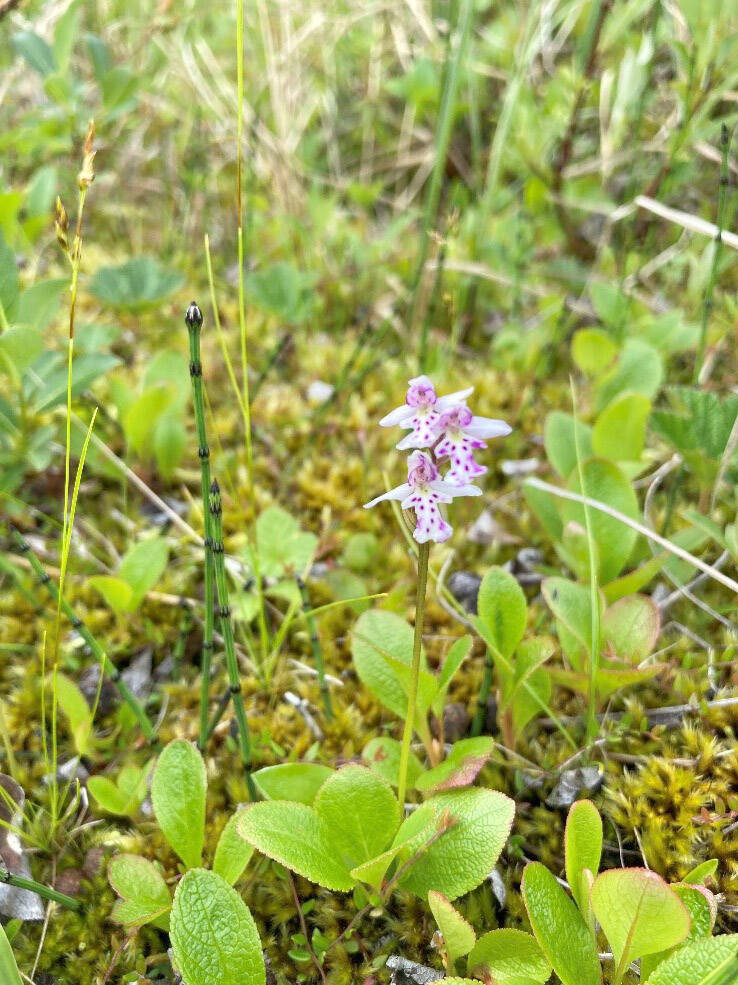Touching down, we could feel the widened skids sink, yet securely, on what was a soggy layer of peat. With a nod from the pilot, we opened the door and carefully exited.
Eyeing quickly to miss the soggy peat holes that can sink a man up to his waist, we stepped onto the muskeg. With my co-worker heading to the storage door by the tail of the helicopter, I could hear the loud rotors spinning.
With our backpacks now on our shoulders, we walked by the pilot’s window and veered off in a line of sight. With our distance secured, we knelt and gave a thumbs up.
With that, the helicopter lifted back, spun left, leaned forward and flew off, the engine and blade sound leaving us only with the soft buzz of its echoes in our heads.
Glancing at the GPS, we headed off to our spot. We were checking on a site that was part of the Refuge’s Long-Term Ecological Monitoring Program, mentioned in the Refuge Notebook article from Sept. 2, 2021. (https://www.peninsulaclarion.com/sports/refuge-notebook-swan-lake-fire-update-how-are-plant-communities-doing/).
We were trudging through boreal peatlands, an environment that is a bizarre landscape to someone unfamiliar with it.
Amazingly, the species of moss Sphagnum that grows so prolifically and consistently can construct meters of deep soil profiles that can move and hold water tables differently than the more widely known mineral soil in the continental United States.
Because the peatlands are low in nutrients, they are very exclusive to the plants that can tolerate such a wet and acidic environment.
Reaching our site, which the Swan Lake Fire only slightly burned, we walked out of our measuring area and began looking at the plant community. The usual suspects were present — black spruce, dwarf birch, Labrador tea, willow, sedge and the cryptic tiny bog cranberry, which to me looks like a gnome’s string of Christmas lights.
On the last quadrat, we noticed a bright, unusual pink color. On closer inspection, we realized we had found a very elegant flower belonging to a roundleaf orchid (Galearis roundifolia).
When the word orchid is heard, many people think of the fragile, beautiful arrangement of deep purple-red and yellow flowers found at the indoor plant center of most grocery stores. Many people, my family included, have lamented the difficulty and finicky nature of orchids.
Their roots, sensitive to not getting too wet, are prone to death if left too long between watering. Yet this plant was alive and well, thriving on a small mound of moss within a boreal muskeg.
Orchids as a group contain 28,000 species and account for up to 11% of all seed plant species worldwide. These plants are not just for windowsills and get-well gift baskets but are for cooking as well.
Vanilla extract, an important ingredient in many desserts, is an oil from the vanilla orchid seed pods. With many orchids living in the tropical area of the world, one would be surprised to find out Alaska is home to many more native orchids than Hawaii.
The roundleaf orchid is a small plant and consists of a single small, round leaf, from which it gets its name. They produce one stem with up to 17 flowers in mid-June.
Roundleaf orchids are finicky and like high pH or not too acidic soils, making them a unique find in a peatland. Thus, orchids may give a clue to the hydrology of this area, classifying it as a fen.
Fens are peatlands with slow-moving surface or subsurface water. This slow-moving water probably helps regulate a higher pH making it a suitable spot for roundleaf orchids than more acidic wetlands.
Orchids as a group are also known for their specialized pollination habits. Roundleaf orchids utilize their lower petal as a lip for pollinators to land on and a spur in the back to hold nectar.
However, roundleaf orchids are not like other flowers and do not carry nectar. Instead, the plant uses its ornate flower and color to deceptively advertise to bees and flies. As the unknowing pollinator lands and comes to the spur to claim its reward, it will reach into the spur for the nonexistent nectar.
As it continues to search, it will press its forehead and break a secret compartment on the flower, spilling what could be called orchid Krazy Glue. This fast-acting substance glues the insect’s head to whatever it is pressing against.
The conveniently placed pollen masses that resemble cotton candy on a stick fit the bill. The pollen found at the base of the “cotton candy stick” is then glued to the pollinator’s face.
As the pollinator gives up its search for nectar, it backs out, and the stick bends, so the pollen is facing down. When the pollinator is tricked at the next roundleaf orchid, the adhered pollen mass on its face is conveniently angled and located to pollinate this next flower.
After marking the orchid down and snapping a photo, we completed our plot and wound up the measuring tape, pulled out flags and marched off the way we came to our landing site. We awaited pickup, then we were shuttled to another section of the refuge to measure the condition of another site.
Now that it is winter and -20, I look back on that project and that tiny flower we noticed and wonder how many other special places hold such unique conditions that a rare plant can find a footing and make a living.
Samuel Artaiz is a Seasonal Biological Technician at the Kenai National Wildlife Refuge and outdoorsman who has a soft spot for aquatic systems. Find more Refuge Notebook articles (1999–present) at https://www.fws.gov/refuge/Kenai/community/refuge_notebook.html.


